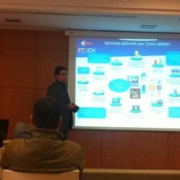TelePresence is similar to a computing server but more complex. For example, endpoints or devices (components) need to be registered first on the VCS (virtual control server) or call manager. It uses licenses first of all.
Then there's another appliance called TB Conductor, which handles routing, and the TelePresence server acts as a bridge for participants joining exchanging ITP or SIP communication. That's how it works.
I typically used TelePresence for team meetings or client interactions. I used to work in a bank with over a thousand branches, each with endpoints. We used it for team meetings instead of physically going to locations. It worked for interactions, trainings, and all those things.
We used TelePresence for large-scale virtual events or conferences. We had weekly meetings with over 50 endpoints, and it worked fine. It was reliable, stable, and good, even though complex. The more resources you give it, the better it works.
I would rate the ease of integration of Cisco TelePresence with other communication tools a ten out of ten, with ten being easy to integrate.
We integrated it with the Call Manager.







